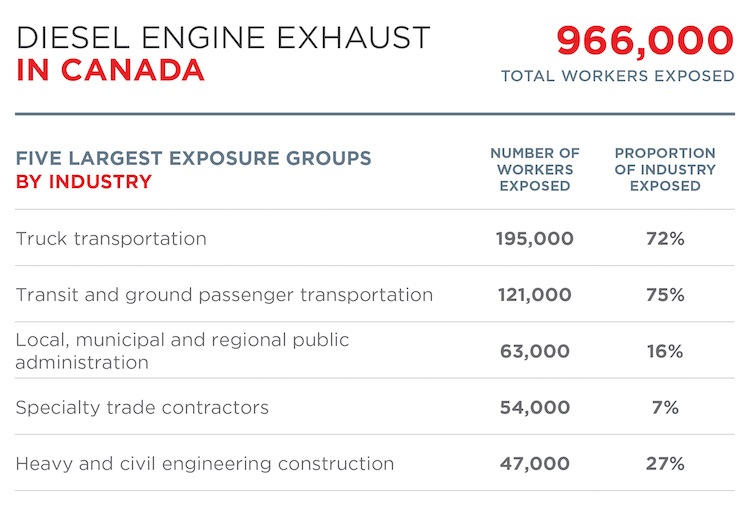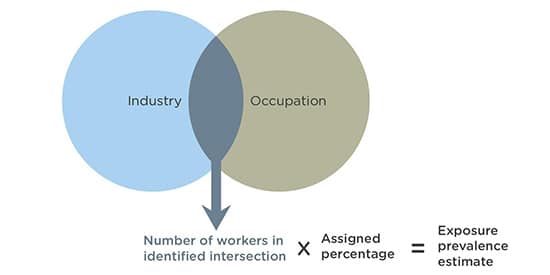Diesel Engine Exhaust Occupational Exposures
Diesel Engine Exhaust Occupational Exposures
Overview
Inhalation is the most important route of occupational exposure.[1] CAREX Canada estimates that approximately 966,000 Canadians are exposed to diesel exhaust in their workplace.
READ MORE...
The two largest industrial groups exposed are truck transportation and transit and ground passenger transportation. The largest occupational groups exposed are transport truck drivers, bus drivers, subway operators and other transit operators, heavy equipment operators, and delivery and courier service drivers.
Additional occupations that may be exposed to diesel exhaust from the use of on-road engines include bus and subway drivers, bus garage workers, trucking company workers, forklift operators, firefighters, lumberjacks, toll-booth and parking garage attendants, traffic controllers, car mechanics, taxi drivers, couriers, and other professional drivers.[1,2] Occupations with potential for exposure to non-road diesel engines include railroad workers, underground mine workers (using diesel powered equipment), forestry (loggers), and those in the marine industry.[1,2]
With the exception of the mining industry, few jurisdictions in Canada have an occupational exposure limit (OEL) for diesel engine exhaust, and none have adopted an OEL that reflects the current state of knowledge, according to our report, “Setting an Occupational Exposure Limit for Diesel Engine Exhaust in Canada: Challenges and Opportunities”. Diesel engine exhaust contains up to 1,800 chemicals, making it a complex mixture that is challenging to monitor. However, elemental carbon has emerged as the best surrogate for measuring diesel exhaust particulate and several international jurisdictions have proposed or adopted occupational exposure limits based on measurement of elemental carbon, including Switzerland, Germany, and Austria. Current scientific evidence supports the need for a more protective occupational exposure limit (OEL) for DEE in Canada.
According to the Burden of Occupational Cancer in Canada project, occupational exposure to diesel engine exhaust leads to approximately 560 lung cancers and possibly 200 suspected bladder cancers each year in Canada, based on past exposures (1961-2001).[3,4,5] This amounts to 2.4% of lung cancer cases and 2.7% of suspected bladder cancer cases diagnosed annually. Most occupational lung cancers associated with diesel engine exhaust occur among workers in the mining and oil and gas extraction sector. These cancers also occur among workers in the transportation and warehousing, wholesale and retail trade, and manufacturing sectors. Work-related diesel engine exhaust exposure resulted in approximately $684 million in costs for newly diagnosed lung and suspected bladder cancer cases in 2011.[4]
Prevalence Estimate
Results show that approximately 966,000 Canadians are occupationally exposed to diesel engine exhaust; 91% are male. This accounts for approximately 5.3% of the working population in Canada. The largest industrial groups exposed to diesel engine exhaust are truck transportation and transit and ground passenger transportation. When exposure is examined by occupation, the largest exposed groups are transport truck drivers (315,000 workers exposed), bus drivers, subway operators and other transit operators (93,000 workers exposed), heavy equipment operators (92,000 workers exposed), and delivery and courier service drivers (56,00 workers exposed).
The number of workers exposed to diesel engine exhaust increased by approximately 69,000 workers from 2006 to 2016 (an 8% increase). This was primarily driven by an increase in the number of workers in transportation and warehousing.
Workers exposed to diesel engine exhaust by industry in 2016

Workers exposed to diesel engine exhaust by region in 2016
Click the second tab to view total number of workers exposed.
* = < 50 workers
Level of Exposure
In total, approximately 966,000 Canadians are exposed to diesel engine exhaust in their workplaces. The majority of workers exposed to diesel engine exhaust are in the low exposure category. A significant number of diesel-exposed workers are at risk for moderate to high exposure.
There has historically been disagreement among experts on what exact components of diesel exhaust should be measured to accurately assess exposure, and thus this data has not been collected consistently or catalogued appropriately in Canada (and most other countries). We assessed level of exposure to diesel exhaust using data published in the peer-reviewed literature.
Workers exposed to diesel engine exhaust by exposure level in 2016
Level of exposure by industry
Identifying industries with either 1) workers exposed to high levels of diesel engine exhaust or 2) a larger number of workers exposed to diesel engine exhaust is important in guiding cancer prevention efforts to prioritize exposed groups and target resources most effectively.
The table below shows the number of workers exposed by industry group and level of exposure to diesel engine exhaust. These results highlight industries with the most number of workers, as well as industries with the highest levels of exposure. For example, in the mining-related industries, where underground work increases the possibility for exhaust to accumulate, the majority of exposed workers fall into the highest exposure category. However, in the transportation industries (484, 485, 488), which have a larger number of total workers exposed, the majority of exposed workers are in the low and medium exposure categories. Depending on the goals of a prevention campaign, exposure reduction in the large industrial group might be a useful strategy, or reducing exposure to those at highest risk of exposure could be seen as a priority.
Workers exposed to diesel engine exhaust by exposure level and industry in 2016
*Numbers may not add up due to rounding
Methods and Data
Our Occupational Approach page outlines the general approach used to calculate prevalence and exposure level estimates for workplace exposures.
Data Sources
Data used in developing the occupational estimates for diesel engine exhaust were collected from several sources:
- Canadian and US scientific peer reviewed publications that addressed diesel engine exhaust exposure in Canada and the United States.
- Grey literature including technical reports from governments and international bodies.
Prevalence Estimate Method
CAREX defines exposure to diesel engine exhaust as inhalation exposure at work above the levels expected in the general environment (i.e. from living close to a highway).
To determine the number of workers potentially exposed to diesel engine exhaust at work, CAREX occupational exposure experts used methods previously established in other peer-reviewed CAREX projects in Europe. A series of steps were taken to assign exposure proportions to occupations and industries at risk of exposure to diesel engine exhaust.

- Occupations and industries at risk of possible exposure to diesel engine exhaust were identified using any combination of data sources described above.
- The total number of workers in each identified occupation and industry intersection was obtained from Statistics Canada 2016 census data.
- A percentage of workers exposed was assigned to that occupation and industry intersection. Percentages were determined by consultation with existing evidence in the data sources, previously established methods from the Europe CAREX estimates and the expert judgement of CAREX occupational hygienists.
- The number of workers in the identified group is multiplied by the assigned percentage to calculate the prevalence estimate of workers exposed to diesel engine exhaust.
Exposure Level Method
CAREX regularly uses available workplace exposure measurements in the CWED to create exposure level categories by industry and occupation. For diesel engine exhaust, these were not available due to a lack of a regulatory exposure limits. Therefore, categories of exposure were created as follows:
Category 1: Low Exposure
A group of workers (people in the same job category and industry) is put in this exposure category for one of two reasons:
- Workers in the job/industry work as drivers in above-ground occupations; or
- Workers are likely to spend time near diesel equipment but not necessarily work with it themselves (bystander exposure); or
- The job takes place near traffic-related sources of diesel-exhaust.
Category 2: Moderate Exposure
A group of workers is put in this exposure category if:
- The job involves repair and maintenance of diesel-powered equipment.
Category 3: High Exposure
A group of workers is put in this exposure category if:
- The job occurs in an underground mine.
Sources
Subscribe to our newsletters
The CAREX Canada team offers two regular newsletters: the biannual e-Bulletin summarizing information on upcoming webinars, new publications, and updates to estimates and tools; and the monthly Carcinogens in the News, a digest of media articles, government reports, and academic literature related to the carcinogens we’ve classified as important for surveillance in Canada. Sign up for one or both of these newsletters below.
CAREX Canada
School of Population and Public Health
University of British Columbia
Vancouver Campus
370A - 2206 East Mall
Vancouver, BC V6T 1Z3
CANADA
As a national organization, our work extends across borders into many Indigenous lands throughout Canada. We gratefully acknowledge that our host institution, the University of British Columbia Point Grey campus, is located on the traditional, ancestral and unceded territories of the xʷməθkʷəy̓əm (Musqueam) people.



